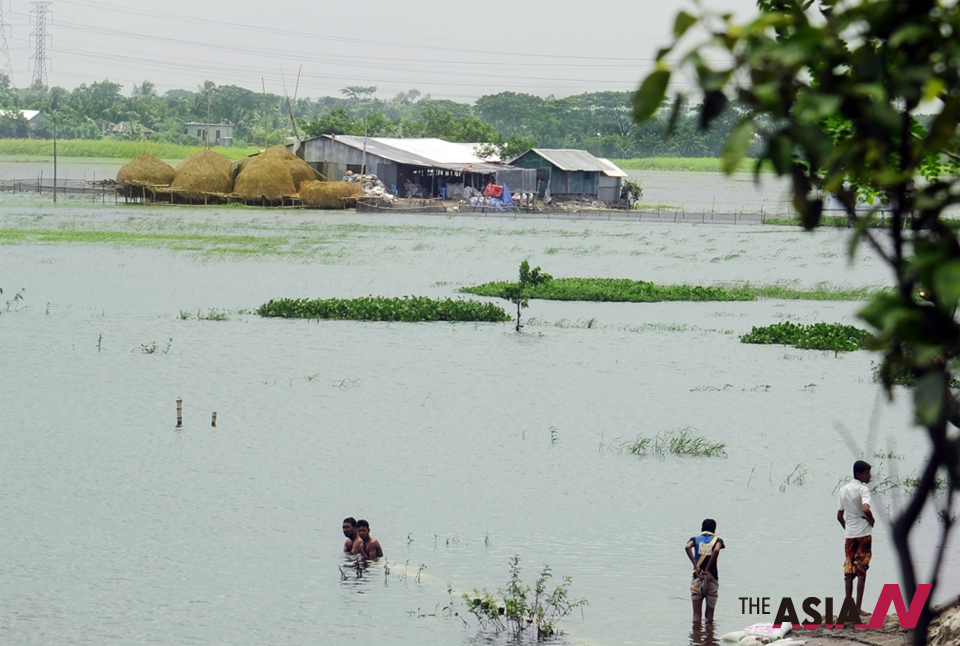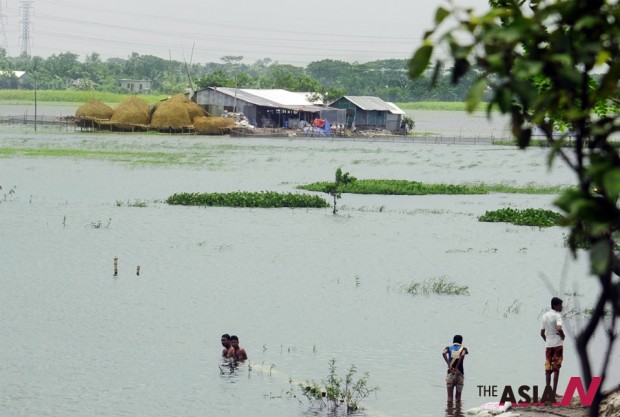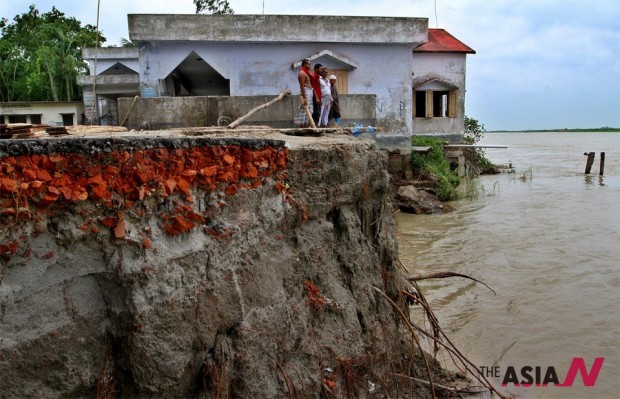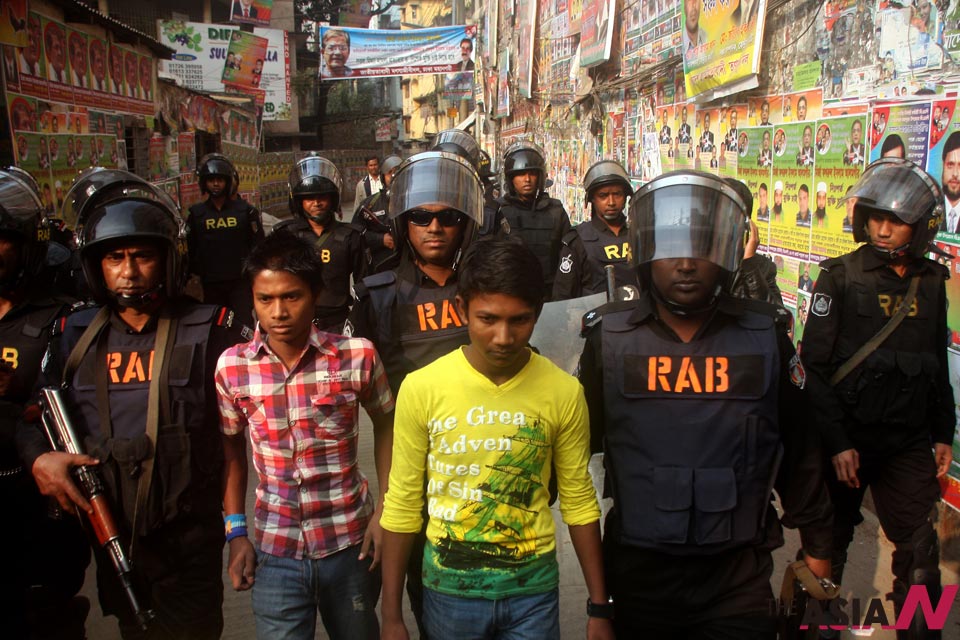
Bangladesh braces early monsoon disaster

Bangladesh flood situation has improved in the northern districts and the north-eastern Sylhet region but the tidal surge in the coastal belt and erosion along the major river system have rendered thousand of people homeless and road communication disrupted in the affected areas.
Meanwhile, waterborne diseases coupled with poor relief efforts, lack of jobs , price hike of essentials , and loss of crops and vegetation have thrown the poor calamity-hit people in untold miseries.
According to Flood Forecasting and Warning Centre (FFWC) the overall food situation in the northern and north-eastern regions were improving rapidly as water levels in the major rivers was falling due to less rainfall in the country and upstream in last few days.
However, the latest FFWC bulletin issued on July 12 said the Brahmaputra-Jamuna, the Ganges-Padma and the upper Meghna rivers showed rising trend which may continue while the Padma in falling trend which may start to rise during next 24 hours. .
All the rivers were, however, flowing below their respective danger levels on Thursday when the centre recorded significant rainfall during the previous 24 hours showing a risk of further flooding.
Indicating the monsoon phenomenon of rains and river water flow , experts fear that any early flooding have the potential risk of getting recurrent spell of flooding during the middle and in the late monsoon.
Another risk factor is that the reduced capacity of rivers to carry flushing water when it comes in big volume from the upper catchments area. Because of low gradients and high sediment loads, the riverbeds of most of the rivers in Bangladesh aggraded in recent decades. Riverbed aggradation is most pronounced for the Ganges and its distributaries.
River erosion
Meanwhile, flooding caused by downpour and onrush of water from the upstream, and high sea tide in the coastal districts, intensified river erosion in different districts during past couple of weeks, damaging several embankments washing away fish farms, devouring homesteads and crop lands on the banks of the rivers.
Water Development Board officials, meanwhile, said that incessant rainfall triggered by a monsoon depression and tidal surges had damaged several flood protection embankments in the southern districts of Barisal , Barguna, Patuakhali and Bhola.
Some 150 houses had been washed away by high tide in Cox’s Bazar coastal district leaving tens of thousands of people stranded in the offshore islands of Kutibdia and Moheshkhali .
In the central district of Faridpur, river erosion at various points along the Padma had intensified in the past few days. About 500 hectares of farm and habitable land were eroded in the districts in the past week forcing more than 400 families to move out of their homesteads. The Padma had eroded about 400 acres of farm and dwelling land in Shariatpur , leaving about 50 families homeless.
The Padma continue to devour croplands and homesteads in Manikganj, Dohar of Dhaka district, Munshiganj and Rajbari. River erosion also continued along the river Brahmaputra and its tributaries in the northern district with hundreds of acres of lands being washed away.
In Jamalpur district , homesteads and several hundred acres of farm land were eroded by the river Brahmaputra while the Jamuna was taking a heavy toll in Sirajganj and Bogra , with river embankments and several hundred acres of farm land being eroded.
Local sources and public representatives said erosion of the Dharla, Teesta, Brahmaputra and Jamuna devoured many houses with lands along riverside places in Kurigram, Gaibandha, Bogra and Sirajganj last week.

Diseases and miseries
Waterborne diseases like dysentery and diarrhea have broken out in the flood affected districts .
Country’s specialized cholera hospital, (International Center for Diarrheal Diseases and Research, Bangladesh -ICDDRB) in Dhaka is experiencing an unusual rise in the number of diarrhea patients in recent weeks
The patient inflow at ICDDRB, the main hospital for treating patients of diarrhea and cholera in the country, increased to more than 600 a day against a normal flow of 200-250 patients
To cope with the situation, extra tents have been set up in the parking space of ICDDRB with the capacity of up to 750 patients.
Water-borne diseases including diarrhoea also broke out among the flood victims in Sylhet district as the flood water was receding. Tens of thousands of people in the affected areas were passing their days in temporary shelters on roads and embankments amid shortage of food, drinking water and medicines.
Sylhet district civil surgeon, Kamrul Hasan, said that 1,080 packets of oral rehydration saline and 1,114 tablets for the treatment of diarrhoea were distributed to the patients. Seventy medical teams were working in the affected areas.
District Relief and Rehabilitation Officer Rafikul Islam estimated that around half-a-million people in the district had been affected by the recent flood.
Relief works
The district and local administration responded to relief and rescue mission according to their ability. However, the early monsoon disaster that affected almost half of the country failed to generate sufficient sympathy among the non-government organisations including various social organisations and the civil society groups which remained always at the forefront in such earlier occasions.
Apart from ruling Awami League and the major opposition BNP, no significant political mobilisation was also observed in relief drive this time.
Meanwhile, Bangladesh Red Crescent Society (BDRCS) distributed relief goods among the flood-affected families of different remote char villages in the northern districts.
The first phase of the Flood Relief Operation – 2012 is being conducted under ‘Emergency Assistance for the Flood Affected People’ to assist the poor people, according to BDRCS officials. займ 30000 рублей срочно на карту без отказа мгновенно




